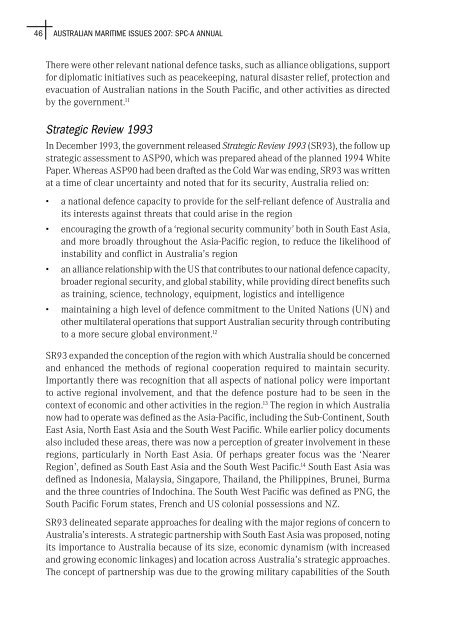Australian Maritime Issues 2007 - Royal Australian Navy
Australian Maritime Issues 2007 - Royal Australian Navy
Australian Maritime Issues 2007 - Royal Australian Navy
Create successful ePaper yourself
Turn your PDF publications into a flip-book with our unique Google optimized e-Paper software.
46 AUSTRALIAN MARITIME ISSUES <strong>2007</strong>: SPC-A ANNUAL<br />
There were other relevant national defence tasks, such as alliance obligations, support<br />
for diplomatic initiatives such as peacekeeping, natural disaster relief, protection and<br />
evacuation of <strong>Australian</strong> nations in the South Pacific, and other activities as directed<br />
by the government. 11<br />
Strategic Review 1993<br />
In December 1993, the government released Strategic Review 1993 (SR93), the follow up<br />
strategic assessment to ASP90, which was prepared ahead of the planned 1994 White<br />
Paper. Whereas ASP90 had been drafted as the Cold War was ending, SR93 was written<br />
at a time of clear uncertainty and noted that for its security, Australia relied on:<br />
• a national defence capacity to provide for the self-reliant defence of Australia and<br />
its interests against threats that could arise in the region<br />
• encouraging the growth of a ‘regional security community’ both in South East Asia,<br />
and more broadly throughout the Asia-Pacific region, to reduce the likelihood of<br />
instability and conflict in Australia’s region<br />
• an alliance relationship with the US that contributes to our national defence capacity,<br />
broader regional security, and global stability, while providing direct benefits such<br />
as training, science, technology, equipment, logistics and intelligence<br />
• maintaining a high level of defence commitment to the United Nations (UN) and<br />
other multilateral operations that support <strong>Australian</strong> security through contributing<br />
to a more secure global environment. 12<br />
SR93 expanded the conception of the region with which Australia should be concerned<br />
and enhanced the methods of regional cooperation required to maintain security.<br />
Importantly there was recognition that all aspects of national policy were important<br />
to active regional involvement, and that the defence posture had to be seen in the<br />
context of economic and other activities in the region. 13 The region in which Australia<br />
now had to operate was defined as the Asia-Pacific, including the Sub-Continent, South<br />
East Asia, North East Asia and the South West Pacific. While earlier policy documents<br />
also included these areas, there was now a perception of greater involvement in these<br />
regions, particularly in North East Asia. Of perhaps greater focus was the ‘Nearer<br />
Region’, defined as South East Asia and the South West Pacific. 14 South East Asia was<br />
defined as Indonesia, Malaysia, Singapore, Thailand, the Philippines, Brunei, Burma<br />
and the three countries of Indochina. The South West Pacific was defined as PNG, the<br />
South Pacific Forum states, French and US colonial possessions and NZ.<br />
SR93 delineated separate approaches for dealing with the major regions of concern to<br />
Australia’s interests. A strategic partnership with South East Asia was proposed, noting<br />
its importance to Australia because of its size, economic dynamism (with increased<br />
and growing economic linkages) and location across Australia’s strategic approaches.<br />
The concept of partnership was due to the growing military capabilities of the South
















